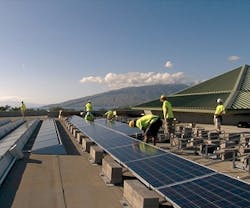For years, energy storage experts puzzled over how to combine two valuable technologies – renewable energy generation and durable energy storage – with the goal of enabling buildings to store solar or wind power for future use.
Today’s challenges revolve around making it simpler, more efficient, and affordable to pair generation directly with storage. It’s not enough that the technology exists – the question now is how to make it a realistic option.
Identifying Today’s Hurdles
Most commercial buildings utilizing renewable energy choose photovoltaic panels, says Don Bradley, International Battery’s business development manager for solar and a member of the Solar Energy Industry Association (SEIA). But most of these buildings dump that power back into the grid to reduce their utility bills instead of storing it.
Conversely, buildings that protect critical data with energy storage systems, like hospitals and data centers, may not link solar panels or wind turbines to storage due to the intermittent nature of many renewable sources of energy. Overcoming these obstacles in a cost-effective way will present a real challenge for developers.
“Policies weren’t in place to fully give value to energy storage, and it flat-out is an easier install to just deploy solar,” Bradley says. “Also, 5 to 7 years ago, we didn’t see the technology in place that was mature enough to do it in a smart grid manner.”
Today’s technology allows building owners to charge batteries or other energy storage devices with renewable energy, but only a few building owners can afford to deploy both at once. The cost of configuring renewable energy storage must come down before it becomes a widely accepted option.
“Making a large percentage of a building’s electrical consumption come from an onsite solar facility is already so costly that adding storage just makes the cost situation worse,” says Jason Makansi, president and consultant for Pearl Street, Inc. “The ‘holy grail’ has very little to do with renewable energy and a lot more to do with making sure they have an uninterrupted electricity supply at the lowest cost possible.”
Driving Technology Development
Boosts for research funding, subsidies on storage units, and the increasing popularity of green prestige are the top drivers of technology development and side-by-side deployment of energy storage and renewable energy harvesters, Bradley and Makansi agree.
The influence of federal and state governments on the industry will have far-reaching effects in the short and long term. Proposed financial incentives in California will help defray the cost of energy storage just like the subsidies that make PV panels, wind turbines, and other green technology financially feasible.
“California is pursuing a 33% renewable portfolio standard by 2020, and it has announced goals of not only 12,000 megawatts of renewable energy, but also 8,000 watts of distributed power,” Makansi says. “So not only is the state incentivizing renewable energy, it’s also incentivizing storage systems on building sites.”
The federal government also earmarked $2.4 billion from 2009’s American Recovery and Reinvestment Act to spur research in batteries for hybrid and electric vehicles. Those discoveries could naturally be adapted to building energy storage, Makansi says.
LEED will also impact the viability of integrating energy harvesting with storage, Bradley adds. “LEED has matured over the years as the technologies have matured. There are now categories that take energy storage and give it the credit it deserves. It’s going to be a design element for architects and engineers to achieve Platinum status.”
What’s Coming Up?
The new crop of storage technologies in development promises to hold more energy, slash the price of storage, and allow greener manufacturing. One project by Aquion Energy is using $20 million in fundraising to produce a sodium ion battery that can handle stationary energy storage, which will provide backup when weather temporarily affects the efficiency of PV panels and turbines.
Developments like this won’t take building owners off the grid completely. Instead, Bradley predicts, these changes will influence the way building owners interact with the grid.
“A building owner who owns a very energy-efficient building and has a PV system on the roof with energy storage can produce electricity during the day, store it in its battery, and then sell it at the most opportune time back onto the grid,” Bradley explains. “Buy low, sell high. That strategy is what we’re working on today.”
Janelle Penny ([email protected]) is associate editor of BUILDINGS.
About the Author
Janelle Penny
Editor-in-Chief at BUILDINGS
Janelle Penny has been with BUILDINGS since 2010. She is a two-time FOLIO: Eddie award winner who aims to deliver practical, actionable content for building owners and facilities professionals.

